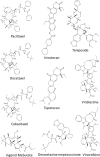Phytochemicals in Cancer Treatment: From Preclinical Studies to Clinical Practice
- PMID: 32116665
- PMCID: PMC7025531
- DOI: 10.3389/fphar.2019.01614
Phytochemicals in Cancer Treatment: From Preclinical Studies to Clinical Practice
Erratum in
-
Corrigendum: Phytochemicals in Cancer Treatment: From Preclinical Studies to Clinical Practice.Front Pharmacol. 2020 Feb 28;11:175. doi: 10.3389/fphar.2020.00175. eCollection 2020. Front Pharmacol. 2020. PMID: 32184731 Free PMC article.
Abstract
Cancer is a severe health problem that continues to be a leading cause of death worldwide. Increasing knowledge of the molecular mechanisms underlying cancer progression has led to the development of a vast number of anticancer drugs. However, the use of chemically synthesized drugs has not significantly improved the overall survival rate over the past few decades. As a result, new strategies and novel chemoprevention agents are needed to complement current cancer therapies to improve efficiency. Naturally occurring compounds from plants known as phytochemicals, serve as vital resources for novel drugs and are also sources for cancer therapy. Some typical examples include taxol analogs, vinca alkaloids such as vincristine, vinblastine, and podophyllotoxin analogs. These phytochemicals often act via regulating molecular pathways which are implicated in growth and progression of cancer. The specific mechanisms include increasing antioxidant status, carcinogen inactivation, inhibiting proliferation, induction of cell cycle arrest and apoptosis; and regulation of the immune system. The primary objective of this review is to describe what we know to date of the active compounds in the natural products, along with their pharmacologic action and molecular or specific targets. Recent trends and gaps in phytochemical based anticancer drug discovery are also explored. The authors wish to expand the phytochemical research area not only for their scientific soundness but also for their potential druggability. Hence, the emphasis is given to information about anticancer phytochemicals which are evaluated at preclinical and clinical level.
Keywords: anticancer; clinical; medicinal plants; phytochemicals; preclinical.
Copyright © 2020 Choudhari, Mandave, Deshpande, Ranjekar and Prakash.
Figures
References
-
- Adams L. S., Phung S., Yee N., Seeram N. P., Li L., Chen S. (2010). Blueberry phytochemicals inhibit growth and metastatic potential of MDA-MB-231 breast cancer cells through modulation of the phosphatidylinositol 3-kinase pathway. Cancer Res. 70 (9), 3594–3605. 10.1158/0008-5472.CAN-09-3565 - DOI - PMC - PubMed
-
- Banerjee S., Bueso-Ramos C., Aggarwal B. B. (2002). Suppression of 7,12-dimethylbenz(a)anthracene-induced mammary carcinogenesis in rats by resveratrol: role of nuclear factor-κB, cyclooxygenase 2, and matrix metalloprotease 9. Cancer Res. 62, 4945–4954. - PubMed
Publication types
LinkOut - more resources
Full Text Sources
Research Materials
Miscellaneous




